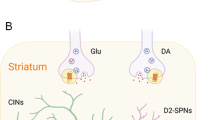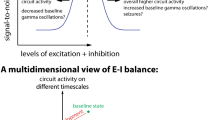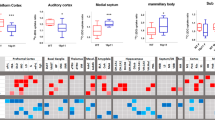Abstract
While localizing sensory and motor deficits is one of the cornerstones of clinical neurology, behavioral and cognitive deficits in psychiatry remain impervious to this approach. In psychiatry, major challenges include the relative subtlety by which neural circuits are perturbed, and the limited understanding of how basic circuit functions relate to thought and behavior. Neurodevelopmental disorders offer a window to addressing the first challenge given their strong genetic underpinnings, which can be linked to biological mechanisms. Such links have benefited from genetic modeling in the mouse, and in this review we highlight how this small mammal is now allowing us to crack neural circuits as well. We review recent studies of mouse thalamus, discussing how they revealed general principles that may underlie human perception and attention. Controlling the magnitude (gain) of thalamic sensory responses is a mechanism of attention, and the mouse has enabled its functional dissection at an unprecedented resolution. Further, modeling human genetic neurodevelopmental disease in the mouse has shown how diminished thalamic gain control can lead to attention deficits. This breaks new ground in how we untangle the complexity of psychiatric diseases; by making thalamic circuits accessible to mechanistic dissection; the mouse has not only taught us how they fundamentally work, but also how their dysfunction can be precisely mapped onto behavioral and cognitive deficits. Future studies promise even more progress, with the hope that principled targeting of identified thalamic circuits can be uniquely therapeutic.
This is a preview of subscription content, access via your institution
Access options
Subscribe to this journal
Receive 12 print issues and online access
$259.00 per year
only $21.58 per issue
Buy this article
- Purchase on Springer Link
- Instant access to full article PDF
Prices may be subject to local taxes which are calculated during checkout





Similar content being viewed by others
References
Butler AB . The evolution of the dorsal thalamus of jawed vertebrates, including mammals: cladistic analysis and a new hypothesis. Brain Res Brain Res Rev 1994; 19: 29–65.
Mueller T . What is the thalamus in zebrafish? Front Neurosci 2012; 6: 64.
Baars BJ, Franklin S, Ramsoy TZ . Global workspace dynamics: cortical "binding and propagation" enables conscious contents. Front Psychol 2013; 4: 200.
Victor JD, Drover JD, Conte MM, Schiff ND . Mean-field modeling of thalamocortical dynamics and a model-driven approach to EEG analysis. Proc Natl Acad Sci USA 2011; 108 (Suppl 3): 15631–15638.
Izhikevich EM, Edelman GM . Large-scale model of mammalian thalamocortical systems. Proc Natl Acad Sci USA 2008; 105: 3593–3598.
Ribary U . Dynamics of thalamo-cortical network oscillations and human perception. Prog Brain Res 2005; 150: 127–142.
Yuste R, MacLean JN, Smith J, Lansner A . The cortex as a central pattern generator. Nat Rev Neurosci. 2005; 6: 477–483.
Stratton P, Wiles J . Global segregation of cortical activity and metastable dynamics. Front Syst Neurosci 2015; 9: 119.
Ferrarelli F, Peterson MJ, Sarasso S, Riedner BA, Murphy MJ, Benca RM et al. Thalamic dysfunction in schizophrenia suggested by whole-night deficits in slow and fast spindles. Am J Psychiatry 2010; 167: 1339–1348.
Nair A, Treiber JM, Shukla DK, Shih P, Muller RA . Impaired thalamocortical connectivity in autism spectrum disorder: a study of functional and anatomical connectivity. Brain 2013; 136: 1942–1955.
Jones EG . The anatomy of sensory relay functions in the thalamus. Prog Brain Res 1991; 87: 29–52.
Jones EG . Synchrony in the interconnected circuitry of the thalamus and cerebral cortex. Ann NY Acad Sci 2009; 1157: 10–23.
Groenewegen HJ, Berendse HW . The specificity of the 'nonspecific' midline and intralaminar thalamic nuclei. Trends Neurosci 1994; 17: 52–57.
Jones EG . Viewpoint: the core and matrix of thalamic organization. Neuroscience 1998; 85: 331–345.
Sherman SM . Thalamus plays a central role in ongoing cortical functioning. Nat Neurosci 2016; 16: 533–541.
Gerfen CR, Paletzki R, Heintz N . GENSAT BAC cre-recombinase driver lines to study the functional organization of cerebral cortical and basal ganglia circuits. Neuron 2013; 80: 1368–1383.
Huang ZJ, Zeng H . Genetic approaches to neural circuits in the mouse. Annu Rev Neurosci 2013; 36: 183–215.
Kawashima T, Okuno H, Bito H . A new era for functional labeling of neurons: activity-dependent promoters have come of age. Front Neural Circuits 2014; 8: 37.
Alivisatos AP, Andrews AM, Boyden ES, Chun M, Church GM, Deisseroth K et al. Nanotools for neuroscience and brain activity mapping. ACS Nano 2013; 7: 1850–1866.
Deisseroth K, Feng G, Majewska AK, Miesenbock G, Ting A, Schnitzer MJ . Next-generation optical technologies for illuminating genetically targeted brain circuits. J Neurosci 2006; 26: 10380–10386.
Deisseroth K, Schnitzer MJ . Engineering approaches to illuminating brain structure and dynamics. Neuron 2013; 80: 568–577.
Sheroziya M, Timofeev I . Global intracellular slow-wave dynamics of the thalamocortical system. J Neurosci 2014; 34: 8875–8893.
Llinas RR, Steriade M . Bursting of thalamic neurons and states of vigilance. J Neurophysiol 2006; 95: 3297–3308.
David F, Schmiedt JT, Taylor HL, Orban G, Di Giovanni G, Uebele VN et al. Essential thalamic contribution to slow waves of natural sleep. J Neurosci 2013; 33: 19599–19610.
Halassa MM . Thalamocortical dynamics of sleep: roles of purinergic neuromodulation. Semin Cell Dev Biol 2011; 22: 245–251.
Halassa MM, Chen Z, Wimmer RD, Brunetti PM, Zhao S, Zikopoulos B et al. State-dependent architecture of thalamic reticular subnetworks. Cell 2014; 158: 808–821.
Wimmer RD, Schmitt LI, Davidson TJ, Nakajima M, Deisseroth K, Halassa MM . Thalamic control of sensory selection in divided attention. Nature 2015; 526: 705–709.
O'Connor DH, Fukui MM, Pinsk MA, Kastner S . Attention modulates responses in the human lateral geniculate nucleus. Nat Neurosci 2002; 5: 1203–1209.
McAlonan K, Cavanaugh J, Wurtz RH . Guarding the gateway to cortex with attention in visual thalamus. Nature 2008; 456: 391–394.
Jeffries AM, Killian NJ, Pezaris JS . Mapping the primate lateral geniculate nucleus: a review of experiments and methods. J Physiol Paris 2014; 108: 3–10.
Contreras D, Denman DJ . On parallel streams through the mouse dorsal lateral geniculate nucleus. Front Neural Circuits 2016; 10: 20.
Martinez LM, Molano-Mazon M, Wang X, Sommer FT, Hirsch JA . Statistical wiring of thalamic receptive fields optimizes spatial sampling of the retinal image. Neuron 2014; 81: 943–956.
Wang X, Vaingankar V, Soto Sanchez C, Sommer FT, Hirsch JA . Thalamic interneurons and relay cells use complementary synaptic mechanisms for visual processing. Nat Neurosci 2011; 14: 224–231.
Hirsch JA, Wang X, Sommer FT, Martinez LM . How inhibitory circuits in the thalamus serve vision. Annu Rev Neurosci 2015; 38: 309–329.
Usrey WM, Alitto HJ . Visual functions of the thalamus. Annu Rev Vis Sci 2015; 1: 351–371.
Pinault D . The thalamic reticular nucleus: structure, function and concept. Brain Res Brain Res Rev 2004; 46: 1–31.
Buschman TJ, Kastner S . From behavior to neural dynamics: an integrated theory of attention. Neuron 2015; 88: 127–144.
Miller EK, Cohen JD . An integrative theory of prefrontal cortex function. Annu Rev Neurosci 2001; 24: 167–202.
Gilbert CD, Li W . Top-down influences on visual processing. Nat Rev Neurosci 2013; 14: 350–363.
Reynolds JH, Pasternak T, Desimone R . Attention increases sensitivity of V4 neurons. Neuron 2000; 26: 703–714.
Zenon A, Krauzlis RJ . Attention deficits without cortical neuronal deficits. Nature 2012; 489: 434–437.
Ling S, Pratte MS, Tong F . Attention alters orientation processing in the human lateral geniculate nucleus. Nat Neurosci 2015; 18: 496–498.
Freedman DJ, Riesenhuber M, Poggio T, Miller EK . Categorical representation of visual stimuli in the primate prefrontal cortex. Science 2001; 291: 312–316.
Zikopoulos B, Barbas H . Pathways for emotions and attention converge on the thalamic reticular nucleus in primates. J Neurosci 2012; 32: 5338–5350.
Elsabbagh M, Holmboe K, Gliga T, Mercure E, Hudry K, Charman T et al. Social and attention factors during infancy and the later emergence of autism characteristics. Prog Brain Res 2011; 189: 195–207.
Dajani DR, Uddin LQ . Demystifying cognitive flexibility: implications for clinical and developmental neuroscience. Trends Neurosci 2015; 38: 571–578.
Kalkstein S, Hurford I, Gur RC . Neurocognition in schizophrenia. Curr Top Behav Neurosci 2010; 4: 373–390.
Chaudhry A, Noor A, Degagne B, Baker K, Bok LA, Brady AF et al. Phenotypic spectrum associated with PTCHD1 deletions and truncating mutations includes intellectual disability and autism spectrum disorder. Clin Genet 2015; 88: 224–233.
Noor A, Whibley A, Marshall CR, Gianakopoulos PJ, Piton A, Carson AR et al. Disruption at the PTCHD1 locus on Xp22.11 in autism spectrum disorder and intellectual disability. Sci Transl Med 2010; 2: 49ra68.
Wells MF, Wimmer RD, Schmitt LI, Feng G, Halassa MM . Thalamic reticular impairment underlies attention deficit in Ptchd1 mice. Nature 2016; 532: 58–63.
Cueni L, Canepari M, Lujan R, Emmenegger Y, Watanabe M, Bond CT et al. T-type Ca2+ channels, SK2 channels and SERCAs gate sleep-related oscillations in thalamic dendrites. Nat Neurosci 2008; 11: 683–692.
Huguenard JR, McCormick DA . Simulation of the currents involved in rhythmic oscillations in thalamic relay neurons. J Neurophysiol 1992; 68: 1373–1383.
Chen Z, Wimmer RD, Wilson MA, Halassa MM . Thalamic circuit mechanisms link sensory processing in sleep and attention. Front Neural Circuits 2015; 9: 83.
Gao R, Penzes P . Common mechanisms of excitatory and inhibitory imbalance in schizophrenia and autism spectrum disorders. Curr Mol Med 2015; 15: 146–167.
Gogolla N, Leblanc JJ, Quast KB, Sudhof TC, Fagiolini M, Hensch TK . Common circuit defect of excitatory-inhibitory balance in mouse models of autism. J Neurodev Disord 2009; 1: 172–181.
Gkogkas CG, Khoutorsky A, Ran I, Rampakakis E, Nevarko T, Weatherill DB et al. Autism-related deficits via dysregulated eIF4E-dependent translational control. Nature 2013; 493: 371–377.
Bridge H, Leopold DA, Bourne JA . Adaptive pulvinar circuitry supports visual cognition. Trends Cogn Sci 2016; 20: 146–157.
Grieve KL, Acuna C, Cudeiro J . The primate pulvinar nuclei: vision and action. Trends Neurosci 2000; 23: 35–39.
Saalmann YB, Pinsk MA, Wang L, Li X, Kastner S . The pulvinar regulates information transmission between cortical areas based on attention demands. Science 2012; 337: 753–756.
Roth MM, Dahmen JC, Muir DR, Imhof F, Martini FJ, Hofer SB . Thalamic nuclei convey diverse contextual information to layer 1 of visual cortex. Nat Neurosci 2016; 19: 299–307.
Saalmann YB . Intralaminar and medial thalamic influence on cortical synchrony, information transmission and cognition. Front Syst Neurosci 2014; 8: 83.
Mitchell AS, Sherman SM, Sommer MA, Mair RG, Vertes RP, Chudasama Y . Advances in understanding mechanisms of thalamic relays in cognition and behavior. J Neurosci 2014; 34: 15340–15346.
Anticevic A, Haut K, Murray JD, Repovs G, Yang GJ, Diehl C et al. Association of thalamic dysconnectivity and conversion to psychosis in youth and young adults at elevated clinical risk. JAMA Psychiatry 2015; 72: 883–891.
Popken GJ, Bunney WE Jr., Potkin SG, Jones EG . Subnucleus-specific loss of neurons in medial thalamus of schizophrenics. Proc Natl Acad Sci USA 2000; 97: 9276–9280.
Ivanov I, Bansal R, Hao X, Zhu H, Kellendonk C, Miller L et al. Morphological abnormalities of the thalamus in youths with attention deficit hyperactivity disorder. Am J Psychiatry 2010; 167: 397–408.
Lakatos P, O'Connell MN, Barczak A . Pondering the pulvinar. Neuron 2016; 89: 5–7.
Conley M, Diamond IT . Organization of the visual sector of the thalamic reticular nucleus in galago. Eur J Neurosci 1990; 2: 211–226.
Bartho P, Slezia A, Matyas F, Faradzs-Zade L, Ulbert I, Harris KD et al. Ongoing network state controls the length of sleep spindles via inhibitory activity. Neuron 2014; 82: 1367–1379.
Halassa MM, Siegle JH, Ritt JT, Ting JT, Feng G, Moore CI . Selective optical drive of thalamic reticular nucleus generates thalamic bursts and cortical spindles. Nat Neurosci 2011; 14: 1118–1120.
Tsien JZ, Chen DF, Gerber D, Tom C, Mercer EH, Anderson DJ et al. Subregion- and cell type-restricted gene knockout in mouse brain. Cell 1996; 87: 1317–1326.
Callaway EM . A molecular and genetic arsenal for systems neuroscience. Trends Neurosci 2005; 28: 196–201.
Jennings JH, Rizzi G, Stamatakis AM, Ung RL, Stuber GD . The inhibitory circuit architecture of the lateral hypothalamus orchestrates feeding. Science 2013; 341: 1517–1521.
Peca J, Feliciano C, Ting JT, Wang W, Wells MF, Venkatraman TN et al. Shank3 mutant mice display autistic-like behaviours and striatal dysfunction. Nature 2011; 472: 437–442.
Peebles D, Cooper RP . Thirty years after Marr's vision: levels of analysis in cognitive science. Top Cogn Sci 2015; 7: 187–190.
Rosenberg A, Patterson JS, Angelaki DE . A computational perspective on autism. Proc Natl Acad Sci USA 2015; 112: 9158–9165.
Carandini M, Heeger DJ . Normalization as a canonical neural computation. Nat Rev Neurosci 2012; 13: 51–62.
Heeger DJ . Normalization of cell responses in cat striate cortex. Vis Neurosci 1992; 9: 181–197.
Olsen SR, Bhandawat V, Wilson RI . Divisive normalization in olfactory population codes. Neuron 2010; 66: 287–299.
Beaudoin DL, Borghuis BG, Demb JB . Cellular basis for contrast gain control over the receptive field center of mammalian retinal ganglion cells. J Neurosci 2007; 27: 2636–2645.
Brouwer GJ, Heeger DJ . Cross-orientation suppression in human visual cortex. J Neurophysiol 2011; 106: 2108–2119.
Pouille F, Marin-Burgin A, Adesnik H, Atallah BV, Scanziani M . Input normalization by global feedforward inhibition expands cortical dynamic range. Nat Neurosci 2009; 12: 1577–1585.
Louie K, Khaw MW, Glimcher PW . Normalization is a general neural mechanism for context-dependent decision making. Proc Natl Acad Sci USA 2013; 110: 6139–6144.
Louie K, Grattan LE, Glimcher PW . Reward value-based gain control: divisive normalization in parietal cortex. J Neurosci 2011; 31: 10627–10639.
Busse L, Wade AR, Carandini M . Representation of concurrent stimuli by population activity in visual cortex. Neuron 2009; 64: 931–942.
Foss-Feig JH, Tadin D, Schauder KB, Cascio CJ . A substantial and unexpected enhancement of motion perception in autism. J Neurosci 2013; 33: 8243–8249.
Vaingankar V, Soto-Sanchez C, Wang X, Sommer FT, Hirsch JA . Neurons in the thalamic reticular nucleus are selective for diverse and complex visual features. Front Integr Neurosci 2012; 6: 118.
Simm GM, de Ribaupierre F, de Ribaupierre Y, Rouiller EM . Discharge properties of single units in auditory part of reticular nucleus of thalamus in cat. J Neurophysiol 1990; 63: 1010–1021.
Katzner S, Busse L, Carandini M . GABAA inhibition controls response gain in visual cortex. J Neurosci 2011; 31: 5931–5941.
Cox CL, Huguenard JR, Prince DA . Nucleus reticularis neurons mediate diverse inhibitory effects in thalamus. Proc Natl Acad Sci USA 1995; 94: 8854–8859.
Haigh SM, Heeger DJ, Dinstein I, Minshew N, Behrmann M . Cortical variability in the sensory-evoked response in autism. J Autism Dev Disord 2015; 45: 1176–1190.
Schmitt L, Halassa M . Regulation of sensory feature selectivity by the thalamic reticular nucleus. Cosyne Abstracts 2016, Salt Lake City, UT, USA, pp 158–159.
Acknowledgements
We thank Dr Laszlo Acsady and Dr Sabine Kastner for their comments. We also thank members of the Halassa lab for constructive discussion and feedback. This work has been funded by grants from the NIH (NIMH, NINDS), Brain and Behavior, Feldstein, Klingestein, Sloan and Simons Foundations.
Author information
Authors and Affiliations
Corresponding author
Ethics declarations
Competing interests
The authors declare no conflict of interest.
Rights and permissions
About this article
Cite this article
Schmitt, L., Halassa, M. Interrogating the mouse thalamus to correct human neurodevelopmental disorders. Mol Psychiatry 22, 183–191 (2017). https://doi.org/10.1038/mp.2016.183
Received:
Revised:
Accepted:
Published:
Issue Date:
DOI: https://doi.org/10.1038/mp.2016.183
This article is cited by
-
The impact of the human thalamus on brain-wide information processing
Nature Reviews Neuroscience (2023)
-
Alterations in TRN-anterodorsal thalamocortical circuits affect sleep architecture and homeostatic processes in oxidative stress vulnerable Gclm−/− mice
Molecular Psychiatry (2022)
-
Mapping thalamocortical functional connectivity with large-scale brain networks in patients with first-episode psychosis
Scientific Reports (2021)
-
Neuroligin 2 regulates absence seizures and behavioral arrests through GABAergic transmission within the thalamocortical circuitry
Nature Communications (2020)
-
Crybb2 Mutations Consistently Affect Schizophrenia Endophenotypes in Mice
Molecular Neurobiology (2019)



